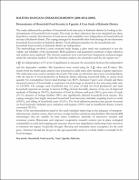| dc.description.abstract | BALINDA BAINGANA ESKAR RICHARDSON (2008-M112-20003)
Determinants of Household Food Security in Uganda: A Case Study of Kabarole District
The study addressed the problem of household food insecurity in Kabarole district by looking at the
determinants of household food security. The study set three objectives that were translated into three
hypotheses, namely; determinants of food access and availability were independent of household food
security in Kabarole district. The coping strategies by households after food shortage do not determine
household food security in Kabarole district. Food utilisation practices by the households and
household food security in Kabarole district are independent.
The methodology involved a cross sectional study design; a pilot study was conducted to test the validity and reliability of the instruments. Both qualitative and quantitative methods of data collection and analysis were employed. The relevant responses were converted into frequencies and percentages under the univariate analysis. Under the bivariate analysis, the researcher used the chi-square test (
2 ) for independence at 5% level of significance to measure the association between the independent and the dependent variables. The hypotheses were tested using the 2 values and P-values. The results from the multivariate analysis were presented as odds ratios after running a logistic regression. The odds ratios were used to interpret the results. The study revealed that, there were several problems with the factors of food production in Kabarole district affecting household ability to access food quantity for consumption. Severe land shortage was 48.3% (between 0 and 1 acre of land) and these increased chances of households to experience food shortage as showed by the increasing odds ratio of 2.413833. On average, each household uses 0.2 acres of land for food production and each household expected on average to harvest 0.25Kg of food. Secondly, absence of any use of improved methods of farming at (96.0%), destruction of food by diseases and pests (96%), poor state of roads (55.7%) absence of storage facilities (98%) also significantly affected household food security. The coping strategies that largely increased household food insecurity included, acquiring food on credit (69.8%), and selling of household assets (41.6%). The food utilisation practices that greatly increased on food insecurity included, poor sanitation and hygiene (100%) and an insufficient dietary content consumed (95.3%).
Some of the recommendations made by the study included: improving on the adequacy of transport
infrastructure, market centres, farm services, storage facilities and processing facilities. Develop bio150
technologies that are suitable for land scarce conditions. Intensify on interactive research and extension system. Rejuvenate and empower cooperative research centres; put in place ecological sustainability in yield and cropping; put measures that reverse degradation; harnessing water resources to minimise the impact of periodic drought. Develop and streamline micro enterprises for the rural poor. Attention should also be put on the agro-pastoralist sector as a whole which is normally hit by food shortages.
Key words: Household, Food security, Food, Uganda, Kabarole | en_US |


